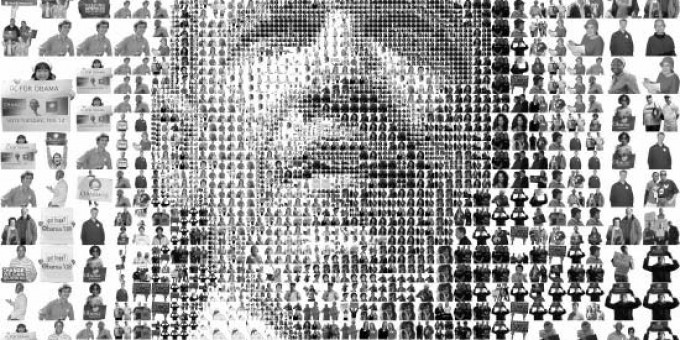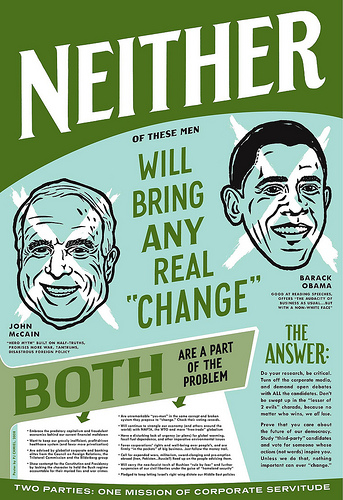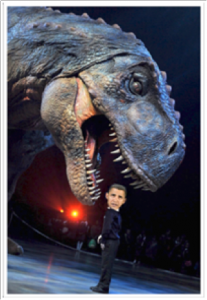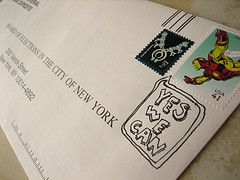
Back in the fall of 2008, Doug Hartmann was editing Contexts magazine. To gain some perspective on what was clearly a historic election, he and the Contexts graduate student editorial board reached out to a number of scholars to get their insights on Barack Obama as a social phenomenon. Now, most of those contributors revisit their 2008 comments four years later.
Election 2: Politics as Usual Strikes Back
by Josh Pacewicz
During the last election and this one, I have been interested to see if the Obama campaign connects with urban leaders trying to address local problems, an issue I investigate via a community study of two Rust Belt cities. This question is interesting, because people feel a part of the imaginary communities to which they are institutionally connected. Ultimately, it is the leaders of local political and civic associations who connect local problems to national political debates – or don’t. My analysis shows that urban leaders are increasingly focused on marketing their cities to outsiders. To this end, they have developed a political culture that revolves around partnerships, or short-term and flexible coalitions that allow leaders to represent the city differently to different audiences. A partner’s reputation is founded upon an ability to avoid divisive issues and this identity increasingly clashes with partisan attachments. The big surprise of my study is that local leaders in my cities have withdrawn from local branches of the two parties and left them in the hands of more-extreme activists. Republican activists, for example, have adopted the mantle of Tea Party since 2008 as a way of distinguishing themselves from the captains of industry who once dominated the local GOP.
In this context, Obama’s rhetoric of overcoming divisions within politics as usual resonated in 2008, even with traditionally-Republican local leaders. I quoted Don in my last opening blurb: a banker and former Chamber of Commerce officer, who voted for Obama because he seemed “capable of bringing a couple of the sides together.” Not so today! “We need some change,” he told me to justify voting Republican, “but I don’t think that Romney is a panacea…Nobody seems willing to give [and] I don’t know who to blame with both sides pointing the finger.” Voters typically grow strident as the election approaches, but I’ve been struck by many local leaders like Don, who seem unhappy with the choices and politically disillusioned in general.
Accordingly, I see the Obama phenomenon as a “signal juncture” to borrow a phrase from Rhomberg: a non-turning point that illustrates the structural forces preventing systemic change. A full catalog of these forces is outside the scope of this blurb. My own work focuses on one of these forces: the growing gulf between a local political economy that rewards parochial and temporary consensus and a national political sphere that rewards obstructionism and emotionally targeted sound-bites. Everyone wants long-term systemic change, but at every level contextual pressures force long-term systemic change off the agenda.From Tragedy to Farce: Four More Years of Obamamerica
by Eduardo Bonilla-Silva

Four years ago, when so many doubted it, I predicted that Obama was going to be elected president. But unlike most analysts, I expressed serious concerns about Obama’s centrist, color-blind, neoliberal, pro-Wall Street, soft-spoken imperialist leanings. Hence my claim in the Contexts-sponsored roundtable that his election was not going to change the fundamentals of America’s racial game. In my more sociological writings on the matter, I argued that his election represented, more than anything else, the highest stage of the Post-Civil Rights regime that emerged in the 1970s. Unfortunately (who can be happy about racial matters not improving?), the record shows I was right!
Obama, like all mainstream politicians do, demobilized the millions of people who were inspired by his campaign after the election was over. And since Obama never learned how to play political hardball, the policies he enacted over the last four years ended up farther to the right than they should have (e.g., the health care reform, the bailout, the financial reform, etc.).
On the race front, as I expected, he did precious little. His fear of been viewed as a “race man” led him to avoid even talking about race. And when he talked about race, he did so in problematic ways. Thus when the Gates incident transpired, he evolved in a week from “the police acted stupidly” (an inaccurate statement as they acted in a predictable, racialized manner) to “I could’ve calibrated those words differently” to finally inviting all parties for a “beer summit” at the White House. Obama’s actions on the Shirley Sherrod incident were inept and his comments on Trayvon Martin’s post-racial lynching were weak.
On foreign policy, Obama has been, as I expected, Bush-light. He ended the war in Iraq (but not the mess), but deepened the intervention in Afghanistan and has continued Bush’s violations on our civil liberties under the cover of the War on Terror. Guantanamo is still open and he expanded Bush’s high tech imperialism by increasing the number of drone attacks. American imperialism in black is perhaps more effective than when it wears its white attire (many critics of American foreign policy seem unable to label Obama’s interventions imperialist) and, thus, much more dangerous.
The tragedy four years ago was that we did not see what was in front of our nose. Today we have no excuses. Yet, instead of placing demands on Obama and criticizing his policies, the liberal-labor-left coalition is still giving him a pass—most seem happy doing so while others justify their stand as supporting the lesser of two evils. Accordingly, the farce this time around is that Obama may win again and we seem content about this prospect even though we know (or should know) it means almost nothing for progressive politics. Obama, like cheap chocolate ice cream, will continue delivering the color, but not the all-important flavor.The Election of the First Black President and the Resurgence of Overt Racism in the U.S. (The T-Rex Awakens)
by Enid Logan

Social scientists have spent a great deal of time recent years writing about covert racism, also known as colorblind racism, have a nice day racism, or racism lite. Many of us have believed ourselves to have entered into a new racial era wherein overt racist sentiments are rarely uttered aloud, and in which the mechanisms that sustain white supremacy, though insidious and impactful, are now much more subtle and hard to pin down. But then Barack Obama ran for, and won the presidency, and Overt Racism once again reared its ugly head. As I have a toddler to whom I am constantly reading dinosaur books, I imagine Overt Racism as a Tyrannosaurus Rex, crashing into the room, making a lot of unnecessary noise, and smashing up the furniture. Plus it seems that he is planning to stick around for a while.
At this juncture, I believe, many scholars and non-scholars alike are trying to figure out just what is going on. How is it that in the era of racial niceties, where racial meaning is most often conveyed through “sanitized” and deracialized discourse, old style racism, overt racism, or “Archie Bunker” racism, has suddenly moved from the fringes to the conservative mainstream?
How is it that a moment that was supposed to represent the nation’s “triumph” over racism has seemingly led to the opposite?
In the last several years, we have seen the vilest of racial imagery applied to the President, his young daughters, and his wife. Particularly visible early on was the signage at the rallies of the so-called “Tea Party” in 2009-2010, in which President Obama was figured variously as an African witch doctor, as Hitler, or as a white-faced “Joker” with black circles around his eyes and bloody red lips. Comments about the Obamas left on the Internet over the past several years have been especially vicious. In November 2009, it was revealed that the top ranked Google search image for Michelle Obama was a photoshopped rendering of her as an ape. As sociologists Adia Harvey Wingfield and Joe Feagin report, in July 2009, one anonymous reader at the Free Republic described 11-year old Malia Obama “as ‘a common street whore’… and went on to “wonder when she will get her first abortion.” And in March of this year, a federal judge circulated an email in which it was implied that Barack Obama had been conceived at a party during which his mother had had sex with both a black man and a dog.
In the last several years, white elected officials have directed much anger and incivility at the President. Consider Congressman Joe Wilson who yelled “You lie!” at Obama from the Senate floor, and Arizona Governor Jan Brewer, who greeted the President with a finger in the face as he arrived at a Phoenix airport. Once considered primarily to be an extremist, fringe political movement, the Tea Party itself has achieved sweeping electoral success, as a number of its candidates were elected to the U.S. Congress during the 2010 mid-term elections, largely on the grounds of their fierce opposition to the President.
During his brief, fake bid for the Republican presidential nomination, business tycoon Donald Trump based his entire political platform on the clearly race-baiting ideology of “birtherism.” This is the view that Obama’s presidency is illegitimate, because his birth certificate is a fake, and he is not a U.S. citizen. While this belief would seem to be a highly illogical and irrational one, an August 2010 poll found that 41% of Republicans and 1 in 4 Americans overall believed that the president was probably lying about his citizenship.
But the most ominous development we have seen in recent years, perhaps, lies in the area of voter policy. Legislatures in 41 states have introduced restrictive voter identification laws in the last year,designed expressly to limit access to vote. Voting rights would particularly be curtailed among the young, the elderly, and non-whites– all liberal-leaning constituencies that are likely to vote for President Obama in 2012. Critics have likened these measures to the poll taxes and literacy tests that restricted African American access to the vote for seven and a half decades after the Reconstruction.
So what has happened? Was Overt Racism always already in the background, ready to reemerge at any moment, and had we just been we fooling ourselves to think that it would stay there? Is this a calculated political strategy on the part of the Right, designed to inflame racial fears and drive whites to the polls on election day? Or does it represent the uncoordinated, inchoate rage of a segment of the white population that perceives itself to be imperiled by the impending “non-white” demographic takeover of the U.S.?I believe it to be a mixture of the two. The reaction demonstrates, first, that for all the claims that Obama is a milquetoast moderate who has brought about very little change and done almost nothing to shake up the status quo, not everyone is in agreement. The reappearance of the T-Rex tells us that white racial anxiety and anti-black hostility in the U.S., as well as an abiding investment in the U.S. as a white nation, run much, much deeper than some had imagined.
Yes We Can?
by Joe R. Feagin

My take on the 2012 election is substantially the same as for 2008. President Obama’s term and campaign for a second have again revealed two important societal realities: the growing political power of voters of color and the systemically racist character of U.S. society.
Obama has succeeded so far in both his campaigns because of personal courage and political sophistication, including in regard to get-the-vote-out organizing and fund-raising—implemented by a staff more technologically savvy than the Republicans. He succeeded in the first election because he got overwhelming majorities of voters of color and liberal whites. In 2008 he got two thirds of the Latino vote, nearly two thirds of the Asian American vote, and more than two thirds of the Native American vote. However, a substantial majority of whites voted for the Republican in 2008, and without voters of color Obama would have lost. Opinion polls in fall 2012 reveal a similar pattern, with Obama still losing a substantial majority of the white vote nationally.
Obama’s campaigns and presidency have dramatically revealed the systemic reality of U.S. racism. One sign is the growth of two substantially different and polarized U.S. electorates–one very diverse with lots of voters of color who turn out best for presidential elections and tend to vote for more liberal Democratic candidates, and another that is mostly white voters with better turnout rates, especially for nonpresidential elections, and tends to vote for usually conservative Republican candidates. According to Bill Bishop’s analyses, in the 2008 election half of all votes were in politically and racially polarized counties where Obama or McCain won by at least 20 percent. Counties where McCain won with a landslide margin were overwhelmingly white. Where Obama won, the black and Latino population averaged 43 percent of the voting age population.
The number of racialized attacks on Obama by whites in the mainstream media, and on Internet websites, has continued to be dramatic. During the 2008 and 2012 campaigns, and his presidency, hundreds of thousands of racist attacks have been made highlighting his “racial outsider” status. Republican activists place great emphasis on Obama’s alleged African-ness, and he has seen vicious animalistic imagery applied to himself and his family by powerful and ordinary whites.The commonplace naïveté in regard to “not racist” white voters and neglect of social science data on explicit/backstage and implicit racism by commentators of all kinds indicate that “colorblind” thinking remains central in covering up the continuing impact of the centuries-old, white racist frame rationalizing stereotyping and discrimination targeting African Americans—including on still likely, large-scale white voter decisions against a black presidential candidate this November 2012.
I have a new edition of my book Yes We Can? (with Adia Harvey Wingfield) coming out early next year, as well as a new book, White Party, White Government, that deals with the long history of white male dominance of the whole American political system and ends on a discussion of white racism, the Republican Party as a white party, and the Obama years. You can also read my feature, “The Obama Era, the 2012 Election, and Systemic Racism” here on The Society Pages for more.

Comments 2
Obama and Racial Dynamics in the US - India Opines — December 24, 2013
[…] Pacewicz , The Social Significance of Barack Obama, Revisited, The Society Pages, Nov 2, 2012, http://thesocietypages.org/specials/obama-revisited/ [accessed 30 November, […]
Friday Roundup: November 2, 2012 » The Editors' Desk — April 1, 2014
[…] “The Social Significance of Barack Obama, Revisited,” by Eduardo Bonilla-Silva, Joe R. Feagin, Enid Logan, and Josh Pacewicz. In which four scholars reflect on and update their thoughts on Barack Obama just before the 2008 election. […]